HP Blackbird 002: Back in Black
by Jarred Walton on September 12, 2007 12:00 PM EST- Posted in
- Systems
Gaming Performance
This is obviously the area where we expect the Blackbird to excel, and as we will see shortly it doesn't disappoint. As mentioned, we did encounter difficulties with 3DMark and F.E.A.R., with the former refusing to run at all and the latter generating wildly fluctuating performance. We also tested Bioshock, one of the best single player FPS games to come out in recent memory. Bioshock runs quite well at most resolutions with all detail settings maxed, but with the shipping drivers CrossFire support was not enabled. We will be testing out the latest Catalyst 7.9 drivers shortly to see if they address any of the difficulties mentioned here.
Besides testing at the overclocked 3.67 GHz and underclocked 2.33 GHz CPU speeds, we also conducted testing with and without CrossFire enabled. We will start with the actual performance scaling charts, but on the next page we will summarize the average performance increases users get from overclocking as well as CrossFire. When looking at the charts below, keep in mind that a relatively flat line indicates that the game is becoming CPU limited, whereas a steeply sloped line shows that the graphics subsystem is the primary bottleneck.

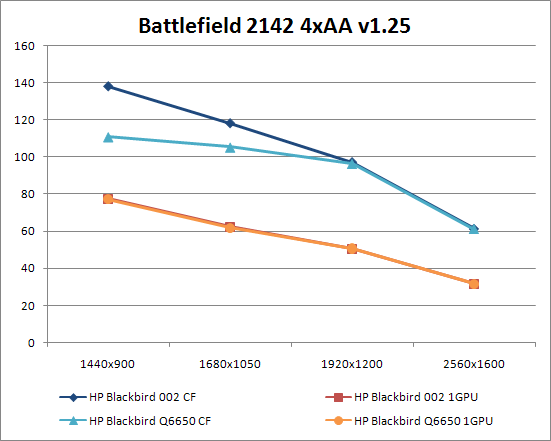
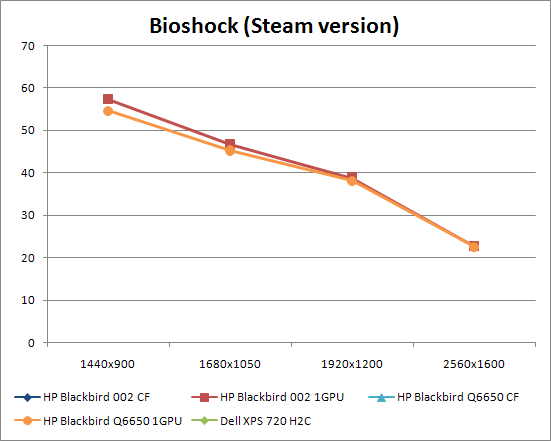
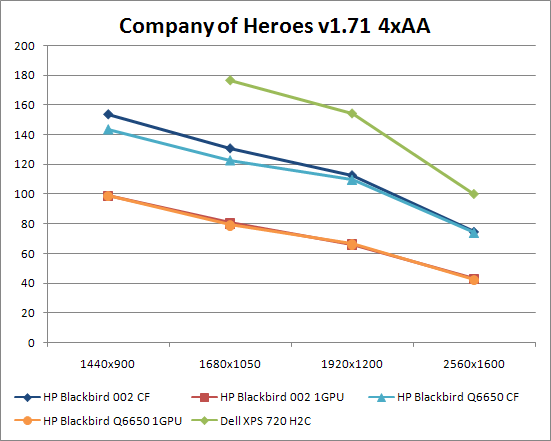
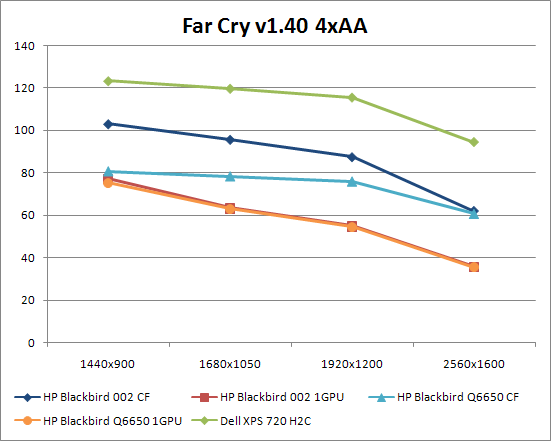
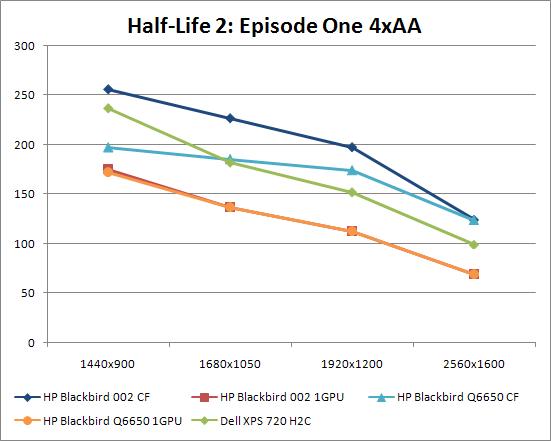




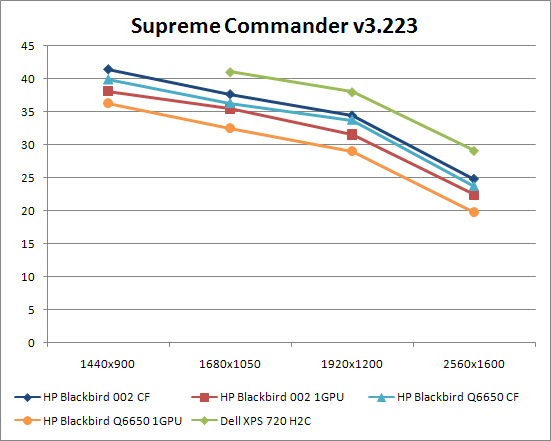
We tested exclusively in widescreen resolutions, and we included the four most common options. However, we feel it's reasonably safe to conclude that anyone purchasing the Blackbird 002 - or any system similar to this - will likely be running at a minimum 1920x1200 native resolution. In fact, if you have over $5,000 to spend on a new computer, we would definitely recommend picking up a 30" LCD to go along with the graphics hardware. Barring that, one of the large 1080p HDTVs would be a good option. What that means is that while we are often CPU limited at the lower resolutions in the above charts, most games are still primarily graphics card limited at high resolutions.
Where we have results from the Dell XPS 720 H2C, it often performs better than the Blackbird 002. While the graphics subsystem in the Blackbird is probably more expensive, the added DDR4 memory really doesn't seem to matter much. S.T.A.L.K.E.R., Company of Heroes, and Far Cry in particular have the SLI setup performing much better than the CrossFire configuration, and testing with older versions of Quake 4 indicates that NVIDIA continues to hold an advantage in that title, particularly under Windows Vista. In other titles, however, performance is a bit more of a tossup. The Half-Life 2 engine for example favors the ATI graphics cards without antialiasing, and performance also generally goes to the CrossFire solution with 4xAA.
Unfortunately, we don't have any Dell XPS results for Battlefield 2142 or Bioshock, and we would also like to rerun some of the other tests just to make sure the XPS numbers are correct. In other words, take the Dell numbers with a grain of salt as they are over two months old and we are unable to verify performance with the latest drivers under Windows Vista.
This is obviously the area where we expect the Blackbird to excel, and as we will see shortly it doesn't disappoint. As mentioned, we did encounter difficulties with 3DMark and F.E.A.R., with the former refusing to run at all and the latter generating wildly fluctuating performance. We also tested Bioshock, one of the best single player FPS games to come out in recent memory. Bioshock runs quite well at most resolutions with all detail settings maxed, but with the shipping drivers CrossFire support was not enabled. We will be testing out the latest Catalyst 7.9 drivers shortly to see if they address any of the difficulties mentioned here.
Besides testing at the overclocked 3.67 GHz and underclocked 2.33 GHz CPU speeds, we also conducted testing with and without CrossFire enabled. We will start with the actual performance scaling charts, but on the next page we will summarize the average performance increases users get from overclocking as well as CrossFire. When looking at the charts below, keep in mind that a relatively flat line indicates that the game is becoming CPU limited, whereas a steeply sloped line shows that the graphics subsystem is the primary bottleneck.











We tested exclusively in widescreen resolutions, and we included the four most common options. However, we feel it's reasonably safe to conclude that anyone purchasing the Blackbird 002 - or any system similar to this - will likely be running at a minimum 1920x1200 native resolution. In fact, if you have over $5,000 to spend on a new computer, we would definitely recommend picking up a 30" LCD to go along with the graphics hardware. Barring that, one of the large 1080p HDTVs would be a good option. What that means is that while we are often CPU limited at the lower resolutions in the above charts, most games are still primarily graphics card limited at high resolutions.
Where we have results from the Dell XPS 720 H2C, it often performs better than the Blackbird 002. While the graphics subsystem in the Blackbird is probably more expensive, the added DDR4 memory really doesn't seem to matter much. S.T.A.L.K.E.R., Company of Heroes, and Far Cry in particular have the SLI setup performing much better than the CrossFire configuration, and testing with older versions of Quake 4 indicates that NVIDIA continues to hold an advantage in that title, particularly under Windows Vista. In other titles, however, performance is a bit more of a tossup. The Half-Life 2 engine for example favors the ATI graphics cards without antialiasing, and performance also generally goes to the CrossFire solution with 4xAA.
Unfortunately, we don't have any Dell XPS results for Battlefield 2142 or Bioshock, and we would also like to rerun some of the other tests just to make sure the XPS numbers are correct. In other words, take the Dell numbers with a grain of salt as they are over two months old and we are unable to verify performance with the latest drivers under Windows Vista.










31 Comments
View All Comments
JarredWalton - Wednesday, September 12, 2007 - link
You have to do a bit more accurate math on the cost. Yes, it's still expensive, but it's not at all a 2-3X mark up.Crazy ATX Case: I'd say this is easily a $500 case. Not that most people need it, but this is not some flimsy plastic thing.
1100W PSU: It looks like this might be a TOPOWER 1100W PSU (it says "TOP-1100W DVT" on a sticker). The 1000W TOPOWER at Newegg costs $330 shipped, so call this on $350.
QX6850: $1200, not overclocked
ASUS Striker: $300
2 x 1GB 2900 XT: $1000
2x1GB Corsair Dominator 8500: $210
160GB Raptor: $190 (technically 10GB more than the normal 150GB Raptors)
750GB Seagate: $210
Logitech G11: $55
Logitech G5: $60
Asetek cooling: $400 for this particular kit seems likely
Blu-ray/HD drive: $880 (Yup, look up the GGW-H10NI - crazy!)
DVDR slot load: $40
Total for parts alone: $4200, and that's going by cheapest online prices.
Still expensive, still a ~50% markup, but then the factory overclock with warranty is worth at least something, right? Anyway, I'm not saying it's a great deal, but if someone told me they wanted me to build them a system like this? Yeah, I'd probably charge at least $1000 to do it, just because I'd want to have some extra for the invariable support costs. "My OC'ed computer just crashed...."
jonnyGURU - Friday, September 14, 2007 - link
Actually, the Blackbird's 1100W is based on Topower's 1200W platform. Tweak and guideline requests (OCP settings, efficiency at different loads, etc.) from HP put the continuous output rating at 1100W. So that's another $50 we need to add for the PSU. FWIW, it's based on the same unit as the ABS/Tagan 1300W (looser standards than HP) which sells for $400.yyrkoon - Wednesday, September 12, 2007 - link
OF al lthe OEM system manufactuers HP probably has one of the better warranties, or so I have been told. Since I do not personally OWN a HP machine, I have to go by word of mouth here. Anyhow, I would venture to say that the warranty on these blackbird system would probably have to be close to Dells Gold service plan.What does this mean ? It means you do not have to play the idiot on the phone for some E. India 'technitian' who probably has less of a clue what is wrong with your system than you do, but rather get to deal with stateside technitians who can actually be helpfull . . . It also means you do not have to wait for some lowly tech to wade through the 'chain of command' to get things replaced/fixed.
Slaimus - Wednesday, September 12, 2007 - link
Is it true that for this system HP somehow got CF to work on a SLI motherboard? If so, does it need special modded drivers like the ULi "GLI" motherboards?wolfman3k5 - Wednesday, September 12, 2007 - link
I doubt that, I will do some research on that and post back. Raul Sood said that they didn't do it with NVidia's help, so if anything was moded, it must be special Catalyst drivers that are being made available only to HP. Sooner or later the "secret" will come out. But I don't imagine that it's something that difficult to do, since ATI uses two CF bridges, and they transfer all rendering data over those, hence, they don't have to rely on the chipset.RamarC - Wednesday, September 12, 2007 - link
but the blackbird line is shipping with at least two motherboard options since there's an amd x2 based blackbird. so two additional mobos could be available for cf/sli.JarredWalton - Wednesday, September 12, 2007 - link
No need to do any research:"ATI CrossFire requires peer-to-peer writes in order to function, and ATI has always maintained that support for this feature is the only thing preventing CrossFire from working on other chipsets, like NVIDIA's SLI chipsets."
If the BIOS is updates so that peer-to-peer PCI-E writes work, CrossFire should work. SLI of course is a given, and getting SLI on non-NVIDIA chipsets is what usually requires hacked drivers. I'll let you know if the stock 7.9 drivers work properly later today when I've had a chance to verify.
n7 - Wednesday, September 12, 2007 - link
I was excited to see this review, mainly because i wanted to see how well their cooling system worked.But there's not a word in this review about the cooling setup, what temps were, was it better than others for OCing etc...
And as for the system itself, sure, it looks nice, & getting SLI or CF working is nice, but 2 GB of RAM?
That's just a big joke when many of us already run 4 GB in our "lowly systems"...
JarredWalton - Wednesday, September 12, 2007 - link
For a 32-bit OS, there's not much need to go beyond 2GB of RAM. Users will almost certainly get the option to install 4GB in the online configurator - and they might even be able to select a 64-bit OS; I don't know yet because the system isn't officially on sale for a few more days.As for the water cooling setup, I haven't tested any other water cooling configs so I can't say whether the Asetek unit in the Blackbird is better or not. It appears to deal with a fully stressed Core 2 Quad @ 3.66 GHz, though I can't be 100% sure that the overclock didn't cause a crash or two. I can look into temperatures for the follow-up, but honestly I think stability is far more important. If a system can manage to run Folding@Home SMP without excessive failures and/or crashes, that's usually a pretty good indication that the overclock is "safe".
wolfman3k5 - Wednesday, September 12, 2007 - link
HP should have known better than installing a 32 bit OS on such a system, because the OS will never be able to address all the video memory. It's about the same as installing 4GB Ram on a 32 bit OS, except that in this situation with 2GB system RAM and 2GB Video Ram, the OS will be able to address closer to 4GB Ram. Other devices also take away some of the 4GB addressing space.As far as CrossFire is concerned, it's not so miraculous that it works on a Striker Motherboard. After all, native crossfire will transfer all data over the two bridges, so it can be chipset agnostic.
It looks like the high performance PC market is pretty profitable, and HP and other companies are going after the boutique manufacturers to try and take away what business is left. But if I want this kind of computer, I'd rather buy from Falcon NW, Puget or build my own. Sorry, not my cup of tea.